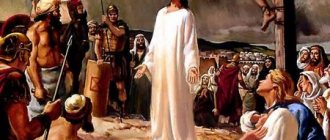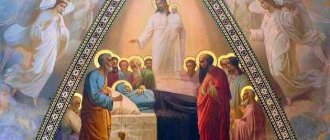What kind of teenager was Jesus Christ? Where and how did he live until he was 30?
Those who are at least a little familiar with Christianity know that Jesus Christ went to preach in Israel only at the age of 30. In the Gospel, all references to His former life end at the age of 12. But where and how did Christ live all these 18 years? Are there any sources that talk about this?
Let us immediately note that there is quite a lot of speculation on this topic. It would be fair to say that they are caused, first of all, by the fact that in the canonical Gospels, which are recognized by Christian churches, nothing is really written about this period. But is it so important if Christ did not do anything at that time that could somehow indicate His divine nature?
The most resonant point of view, perhaps, is associated with the statements of some Western and other scientists that Jesus spent these 18 years in India, in Tibet. This theory originated at the end of the 19th century. If you remember, it was precisely at this time that the esoteric direction became especially fashionable among the Russian and not only intelligentsia. The Roerichs went on an expedition to the Middle East and beyond, but the journalist, writer and avid adventurer Nikolai Notovich put forward a theory and published a book about the young and mature years of the life of Christ. It was in this book that the theory was first voiced that Jesus traveled to India and there for many years he studied healing, Eastern philosophy and many other skills that were so useful to Him after the appearance of a group of disciple-apostles.
This theory was picked up already in the second half of the 20th century, and even Catholic priests seriously adhered to it. Supporters of this version support their opinion by the fact that Notovich allegedly met with Tibetan monks who showed him a number of manuscripts in which the name of Christ was mentioned. However, there is documentary evidence that already in 1895, just a year after Notovich’s trip to India, Professor J. Douglas went there, also puzzled by such amazing discoveries. So, after talking with the monks there, Professor Douglas came to the conclusion that they had not seen or heard of any Russian traveler who was interested in such things. Orientalist Max Muller also conducted his own investigation and realized that Notovich’s speculations were a lie.
What do Orthodox priests say about this? If you believe the words of fairly well-known Orthodox clergy (the opinion of Oleg Stenyaev, Dimitry Smirnov, etc.), then for Christian teaching the “young years” of Jesus did not play such an important role. The fact is that in those centuries an Israeli could devote his life to serving God only from a mature age, from the age of 30. Until this age, the community would not accept his words. As they say, a person first had to “establish himself” as a pious and respected citizen, and only then begin to teach someone else or preach throughout the land of Israel.
The Orthodox Church does not advise taking into account non-canonical gospels. According to the authoritative holy fathers, a person must have certain knowledge in this area in order to correctly interpret what is written in such documents. In Jesus there was not only a human nature, but also a divine nature. This is the most important of the pillars of all Christianity. So why did God need to go somewhere in order to master some knowledge and skills that are already within His control?
At the dawn of the new era, the Israelites lived according to the usual commandments of Moses.
Therefore, children had to obey their parents. Most likely, Christ, being for everyone the son of the carpenter Joseph, helped his father in his craft. Christians should not doubt the piety of Jesus. He would not have had so many disciples and followers if He had not shown by his example and his whole life what service to God and love for one’s neighbor is. Read more here
Where is God now?
On the day Jesus ascended, the disciples stood stunned, like children who had lost their parents. Two angels sent to calm them asked a rhetorical question: Men of Galilee! Why are you standing and looking at the sky? The sky was clear and empty. And yet they stood and watched, without looking up, not knowing how to continue their work and what to do next.
The Savior left few traces of Himself on earth. He did not write books, He was a wanderer and did not leave home or a place that could now serve as his museum. He was not married, did not live a settled life, and left no offspring behind Him. In fact, we would not have known anything about Him if not for the traces that He left in human souls. This was His intention. The Law and the Prophets focused like a beam of light on the One Who was to come. And now this light, as if passing through a prism, must dissipate and shine in the spectrum of movements and shades of the human soul.
But maybe it would be better if there was no Ascension? If Jesus had remained on earth, He could have answered our questions, resolved our doubts, and been a mediator in our ideological and political disputes. Six weeks later the disciples will understand what Jesus meant when he said: It is better for you that I go. Blessed Augustine expressed this well: “You exalted yourself before our eyes, and we turned away in grief to find you in our hearts.”
The Church serves as an extension of the Incarnation, the main way in which God manifests himself in the world. We are “Christs after Christ”, the Church is the place where God lives. What Jesus brought to a few people - healing, grace, the good news of the teaching of divine love - the Church can now convey to everyone. This was the very challenge, the great mission that the Savior conveyed to the disciples before disappearing from their sight. If a grain of wheat falls into the ground and does not die, he explained earlier, then one will remain; and if it dies, it will bear much fruit.
It is much easier for us to believe that God became incarnate in the person of Jesus Christ of Nazareth than that He can be incarnate in the people who enter our Church. However, this is exactly what faith requires of us; this is what life requires of us. The Savior has fulfilled his mission - now it’s up to us.
But how often do we forget about this? We forget how important our prayers are. How important it is for God what I choose today, here and now. And my choice brings joy or sorrow to God. How often do we forget that there are those nearby who need our love and help. We live in a world of cars, phones, the Internet, and the reality of this material universe suppresses our faith in God, who fills the whole world with Himself.
Ascending, the Savior risked being forgotten. And He knew about it. The four parables at the end of Matthew's Gospel, some of the last that Jesus told, have a common theme underlying them. The owner leaves his house, the leaving landowner dismisses his servants; the groom arrives too late, when the guests are already tired and asleep; the master distributes the money to his servants and leaves - all this revolves around the theme of the departed God.
Indeed, the fundamental question of our time is: “Where is God now?” The modern answer is that the Master abandoned us, leaving us free to set our own rules of the game.
If there is no God, as F. M. Dostoevsky said, then everything is permitted. But there is the most powerful and most terrible parable in the Gospel, which talks about how God will judge the world. This is the parable of the goats and the sheep. But notice how it is logically connected to the four parables that precede it.
Firstly, it shows the return of the Master on the Day of Judgment, when a high price will have to be paid - in the literal sense of the word. The departed will return, and this time in power and glory, to sum up everything that has happened on earth.
Secondly, the parable refers to that time period, to that centuries-old interval in which we now live, to a time when it seems that there is no God. The answer to this most modern question is both striking in its depth and frightening. God never disappeared at all. Rather, He put on a mask, the most unsuitable mask for Him, the mask of a stranger, a poor man, a hungry man, a prisoner, a sick man, the most outcast on earth: truly I say to you, just as you did it to one of the least of these My brothers, you did it to Me. If we cannot identify God's presence in the world, then perhaps we have been looking in the wrong place.
There is a wonderful old film called Whistle Down the Wind. Unfortunately, it is not available in Russian dubbing. In this film, two children, playing in a village barn, come across a tramp sleeping in straw. "Who are you?" – the children asked in a demanding voice. The tramp woke up and muttered, looking at the children: “Jesus Christ!” What he said as a joke, the children accepted as the truth. They truly believed that this man was Jesus Christ, and they treated the tramp with horror, respect and love. They brought him food and blankets, spent time with him, talked to him and told him about their lives. Over time, their tenderness transformed the tramp, an escaped criminal who had never before encountered such mercy.
The director who wrote the story intended it to be an allegory of what could happen if we all took Jesus' words about the poor and needy literally. By serving them, we serve Christ.
When we think about the parable of the Last Judgment, many of our own questions to God return to ourselves, like a boomerang. Why does God allow babies to be born in the ghettos of Brooklyn and on the river of death in Rwanda? Why does God allow prisons, homeless shelters, hospitals, and refugee camps to exist? Why didn't Jesus bring order to the world during the years He lived in it?
According to this parable, the Savior knew that the world He left behind would include the poor, the hungry, the imprisoned, the sick. The plight of the world did not surprise Him. He made plans that included it: His long-term and short-term plan. The long term plan involves His return in power and glory, and the short term involves the transfer of power to those who will ultimately become the harbingers of the freedom of the Cosmos. He ascended so that we could take His place.
“Where is God when people suffer?” – we often ask. The answer is another question: “Where is the Church when people suffer?” "Where am I when this happens?" The Savior ascended to heaven in order to leave the keys to the Kingdom of God in our trembling hands.
Why are we so different from the Church Jesus described? Why does She, the Body of Christ, resemble Himself so little? I cannot give a decent answer to such questions, since I myself am part of this problem. But, if you look closely, each of us must ask ourselves this question. “Why am I so little like Him?” It was me, not him, not this or that priest, parishioner or someone else. Namely me! Let each of us try to give ourselves an honest answer to this difficult, but the most important question of our lives...
God, choosing between manifesting Himself in “continuous miraculous intervention in human affairs” or allowing Himself to be “crucified in time” as He Himself was crucified on earth, chooses the second option. The Savior bears the wounds of the Church, this Body of His, just as He bore the wounds of the crucifixion. Sometimes I wonder which wounds cause him more suffering...
Why doesn't the Bible say anything about Jesus' 17 years of wandering?
Author of the question: Olga N.
- Olga asked us the following question: “ Why doesn’t the Bible say anything about the 17 years of Jesus’ wanderings (from 12 to 33 years old)?
Is anything known about this? »
We are talking about the period of life of Jesus Christ from 12 years old, when He was in the Jerusalem temple with his parents, and until 30 years old, when He was baptized by John and began to serve? It is strange why many people declare with such confidence that the Bible says nothing about this period of the life of Jesus Christ. The Evangelist Luke wrote very clearly and definitely about him: “ And He went with them
[that is, with his parents - approx.
author] and came to Nazareth;
and was in obedience to them. And His Mother kept all these words in Her heart. But Jesus increased in wisdom and stature, and in favor with God and men ” (
Luke 2:51-52
). Luke, whose works are distinguished by their particular historical accuracy and accuracy, could not miss this period of the life of Jesus Christ and pointed out that Jesus did not wander or hang out anywhere, as many believe, but lived quietly and peacefully in Nazareth with His earthly parents Joseph and Mary, as well as with his brothers and sisters, developing mentally, physically, spiritually and socially like all his contemporaries. Satan, whose goal, as we know, is to “steal, kill and destroy” (John 10:10), from time to time gives people “ideas” that during these years Jesus traveled to India and Tibet, where he allegedly studied yoga and eastern wisdom. The purpose of this satanic lie is obvious - to show the superiority of Eastern wisdom over Christianity and, thus, to drag unsteady souls into destruction.
Jesus lived in his family and, as the eldest son, took care of the family, fulfilling the duties of his father: taking care of his mother and brothers and sisters. He was well known in His country, in His city, and in the city synagogue. “Isn’t he the son of carpenters?” - people were surprised when they heard his wise teaching and his compatriots: Matthew 13:54-57
“
And having come to His own country, He taught them in their synagogue, so that they were amazed and said: Where did He get such wisdom and power?
Isn't He the son of carpenters? Is not His mother called Mary, and His brothers Jacob and Joses and Simon and Judas? and are not His sisters all among us? Where did He get all this from? And they were offended because of Him. Jesus said to them, “A prophet is not without honor except in his own country and in his own house .”
If Jesus had wandered around other countries for 17 years, it is unlikely that anyone would have recognized Him in Nazareth, the city in which He grew up and matured. Israel has always been and remained a fatherland for Jesus Christ, about which He said “ there is no prophet in his own country
” (
Matthew 13:57
).
Jesus grew up in Israel, was raised and taught in the Law of God, so that already at the age of 12 he amazed the elders with his wisdom and depth of thought, for “ all who heard Him were amazed at His understanding and His answers
” (
Luke 2:47
).
The Bible does not give details about these years of Jesus' life because it does not play any role in our salvation. The Apostle John said that all the miracles Jesus performed during His earthly ministry cannot be written down on paper: “ Jesus did many other things; but if we were to write about it in detail, then I think the world itself would not be able to contain the books written
m" (
Gospel of John 21:25
). In other words, only a small fraction of the miracles of Jesus Christ are described in the Bible. Is it any wonder that it does not describe the everyday life of the child and adolescent Jesus! After all, His life before the first miracle performed in Canna of Galilee was an ordinary family life, and not a ministry.
In addition, in answering this question, it is necessary to make it clear that in Jewish culture a man did not leave his home until he got married. And as we know, Jesus was not married, which is why he lived all these years with his family.
And why did Jesus Christ need to go to Tibet to study and teach yoga? How can the pagan teachings of yoga compare with the depth, wisdom and holiness of sound biblical teaching? Even if we assume that Jesus was a yoga teacher with 17 years of practice, why did He teach differently during His ministry in Israel? Where is the logic??? And finally, Jesus said about himself that His mission was primarily to proclaim the truth not to the Gentiles, but to the Jews: “ I was sent only to the lost sheep of the house of Israel.”
"(
Matthew 15:24
). Having such a mission, how could Jesus go to Tibet and spend 17 years of his life on the Tibetan pagans, leaving only 3 years to fulfill His direct destiny and ministry? Of course no! If Jesus said to the Samaritan woman (the Samaritans were a mixture of Jews and pagans) that he was sent to serve the people of Israel, then wouldn’t He really say the same thing to the Tibetan monks? He would definitely say it at a meeting if such an opportunity presented itself. But from the Holy Scriptures we learn that nothing like this happened, and could not have happened.
We recommend that you read the following articles:
- “How many roads are there to God?”
- "Who is Jesus Christ?"
- "True Disciples of Christ"
- The most important question
Ask your question
Send your question by mail
Back
British archaeologist believes he has found the house of Jesus Christ (10 photos)
Author: Eva Tushenkina
24 November 2021 12:47
Community: Science
Tags: Joseph archeology Bible hypotheses Jesus interesting research excavations
7268
10
Archaeologist from the University of Reading, Professor Ken Dark, has been conducting research for almost 15 years at the excavation site in Nazareth, where, according to legend, Jesus Christ was born. The scientist believes that the ruins, found back in the 1880s, are highly likely to be the place where Joseph, Mary and the baby Jesus lived. And he provides evidence.
0
See all photos in the gallery
The stone-walled dwelling was carved out of a limestone hill and had several adjoining rooms; one doorway remains. There are two tombs on either side of the house.
0
Source:
This place was discovered in the 80s of the 19th century under the monastery of the Sisters of Nazareth. The nuns whose order owned this monastery carried out excavations until the 1930s, believing that they had found the childhood home of Jesus. They relied on a claim made by renowned biblical scholar Victor Guerin in 1888, but never found any evidence. The site was further excavated by a Jesuit priest from 1936 to 1964, after which scientists "almost forgot" about it until Professor Dark began a new project in 2006. In 2015, he published a paper based on initial findings from the excavation site and suggested that it was the home of Mary and Joseph. Subsequent analysis confirmed that the house dates back to the 1st century AD. e., which can serve as one of the proofs of the correctness of the scientist’s hypothesis.
0
Source:
The house is located under the convent of the Sisters of Nazareth, which is across the street from the Church of the Annunciation in Nazareth.
0
Source:
The researcher believes that the builder of the house was probably Joseph, the father of Jesus. It is well known that Joseph was a carpenter, but in the New Testament he is also referred to as a tekton - a craftsman who could build a house. The dwelling was probably a house with living and storage areas next to a courtyard and roof terrace. Whoever built this house was very knowledgeable about stone processing.
0
Source:
After the death of Jesus and the spread of Christianity based on his teachings, a cave church was built around the fourth century on a hill adjacent to a first-century house. It was elaborately decorated with mosaics and had features associated with public worship, including a white marble screen. Then, probably in the fifth century, another large above-ground church was built, over a first-century house and a fourth-century cave church.
0
Source:
This second church was also decorated with mosaics, marble column capitals and architectural decoration. “The later church was the largest in Nazareth of the fifth to seventh centuries (that is, Byzantine),” says the professor. “Whoever did these buildings must have considered the site quite revered from a religious point of view.”
0
Source:
The Convent of the Sisters of Nazareth is located in the center of modern Nazareth, in close proximity to the famous Church of the Annunciation, which has existed for many centuries. The Church of the Annunciation was originally built on the site where Mary is said to have been told by an angel that she would give birth to Jesus, and was built around the same time as the fifth-century church built on the remains of the house. This suggests that the 5th century church above the "house of Jesus" was considered "equally important".
0
Source:
In addition, the house exactly matches the description made by the Byzantines in ancient times - in 670 AD.
0
Source:
Church of the Annunciation in the city of Nazareth in the Galilee in northern Israel. This is what she looks like today.
0
Source:
Ken Dark's new book, in which he details his research, is called "The Convent of the Sisters of Nazareth in the Times of the Romans, Byzantines and Crusaders."
Source: - translated specifically for
Related links:
- Lara Croft's dream hotel opens in Turkey
- Figurines found in Israel that may be images of the god Yahweh
- Archaeologists have found a mysterious temple in Peru
- Israeli archaeologists unearthed a biblical fortress
- Ancient curse tablets found in Greece
subscribe to the Science community
Tags: Joseph archeology Bible hypotheses Jesus interesting research excavations
Did you like the post? Support Chips, click:
61 18 43
Liked
43 2
88
Partner news










